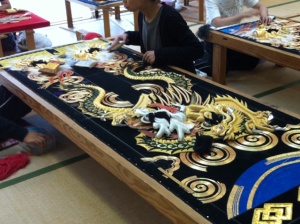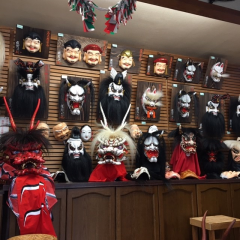Iwami Kagura Costumes Atelier
Iwami Kagura’s costumes atelier ~ Kagura shop “Kuwanoki”
First, I’d like to explain about Iwami-Kagura.
According to Iwami Kagura website, Kagura is the traditional sacred service dance (called Kagura-Mai) for the God/Goddess of the local Shinto shrine during annual rice-crop growth festivities.
The traditional Shinto ritual ceremony takes place at the main alter of the shrine during the day by Shinto priests and female attendants who perform a simple yet graceful sacred service dance called Mai. Then, a series of Iwami-Kagura dance episodes (or stories) follows this ceremony and runs on the Kagura-Den (sacred stage) in the precincts of the shrine from early night to dawn.
We can say that Kagura is our culture, entertainment, and a part of our life in the Iwami area.
We went to the Atelier where Iwami Kagura’s masks&costumes are made and sold.
It located in Kanagi, near Kintano Sato
In this atelier, people with special needs are also working as craftspersons to make these beautiful costumes.
The costumes are hand-made and intricately sewn Kimono dresses are decorated with glittering gold and silver threads. The masks are exaggerated, vividly colored, and deformed to emphasize the original nature of good and evil characters. These costumes take years to make.
All masks (Men) are hand-made and colorfully painted, then lacquered  for protection.
for protection.
Most masks are created from Japanese hand-made papers. In this Atelier, they use Sekisyu-Washi
Performers wear masks in certain episodes. You may enjoy watching a series of mask changes from gentle facial expressions to evil spirited expressions during scenes.
Some Kagura-Men(masks), such as Han-nya(Prajna) masks are used as a charm against evil spirits, usually displayed on walls.
This is the eight-headed (monster) serpent called Yamatano Orochi which is very popular for Kagura. They are making the body of Yamatano Orochi.








